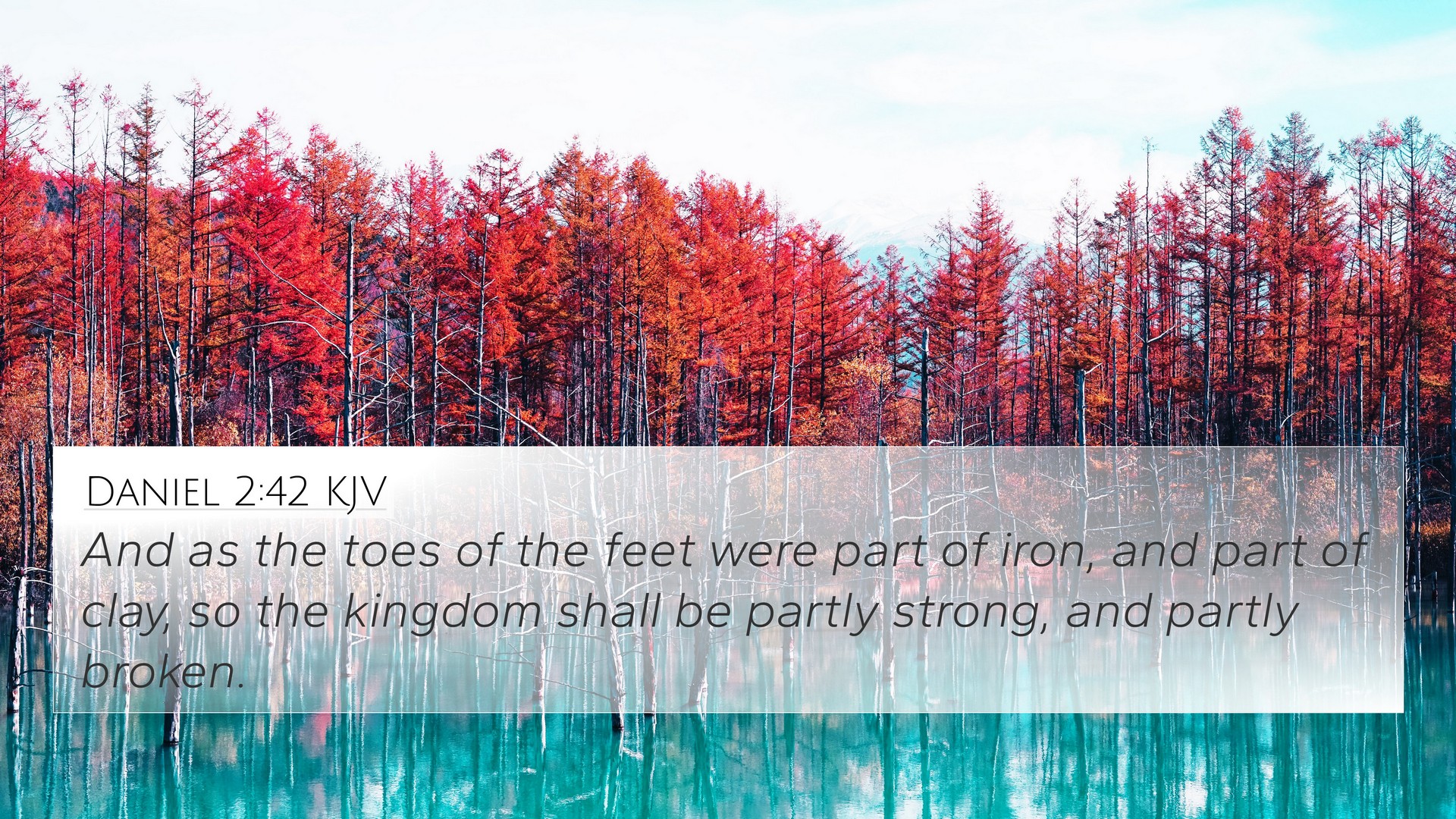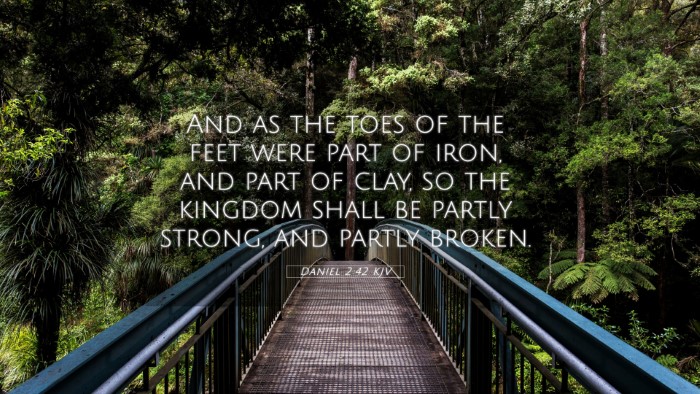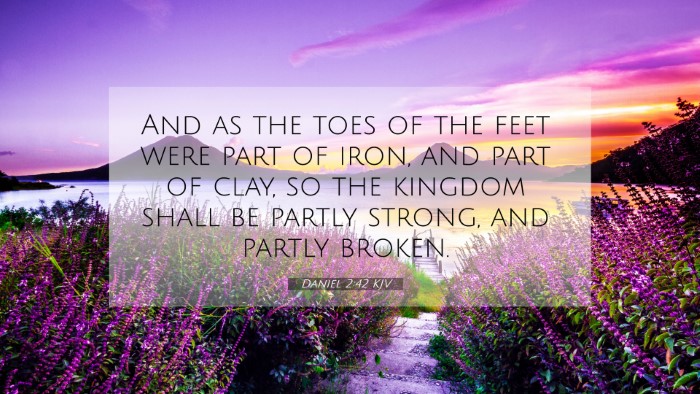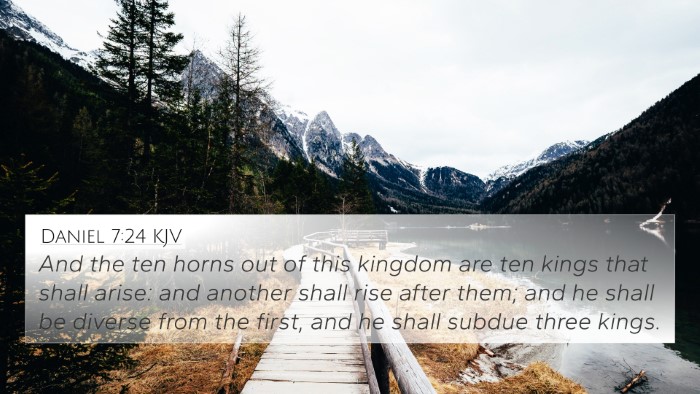Understanding Daniel 2:42
Daniel 2:42: "And as the toes of the feet were part of iron, and part of clay, so the kingdom shall be partly strong, and partly broken." This verse is part of the interpretation of Nebuchadnezzar's dream by Daniel, which symbolizes the nature of future kingdoms.
Summarized Meaning
In this verse, Daniel describes the final phase of the empires represented by the statue in Nebuchadnezzar's dream. This phase is characterized by a dual composition of strengths and weaknesses, epitomized by iron and clay. The combination signifies that the last kingdom will be a mixture of power and fragility.
Insights from Public Domain Commentaries
- Matthew Henry: Matthew Henry explains that the feet, composed of iron and clay, represent the divided nature of the last empire, illustrating that it will not be as cohesive or powerful as the previous kingdoms, ultimately leading to its downfall.
- Albert Barnes: Barnes notes that the iron denotes strength, while the clay symbolizes fragility. The imminent conflicts and struggles that such a mix represents may lead to instability, suggesting that the nations could be strong in some aspects but vulnerable in others.
- Adam Clarke: Clarke elaborates on the prophetic implications of mixing the strong (iron) with the weak (clay), indicating that human governments will struggle to maintain unity. Clarke asserts that this is reflective of the political landscape in the latter days and the multiple factions that may exist.
Thematic Connections
This verse can be cross-referenced with several other scriptures that explore themes of human governance and the eventual kingdom of God:
- Revelation 17:12-13: Discusses the kings that will receive authority and unite, emphasizing the fragmentation of political power.
- Matthew 12:25: Jesus states, "A kingdom divided against itself cannot stand," highlighting the futility of divided governance.
- Isaiah 28:17: Here, the idea of a foundation being mixed with judgment, implying the vulnerability of any regime that lacks divine backing.
- Hebrews 12:28: The assurance of receiving a kingdom that cannot be shaken contrasts the instability represented in Daniel 2:42.
- Luke 21:25: Prophecies of distress among nations foreshadow the fragmentation of political authority heralded in Daniel's vision.
- 1 Corinthians 3:12: Paul speaks to the materials used for building God’s structure, which may also depict resilience versus fragility.
- Daniel 7:23: Directly correlates with the empires represented in the dream, indicating their nature of governance and eventual downfall.
- Proverbs 14:28: "In a multitude of people is the king's honor: but in the want of people is the destruction of the prince," signifies that strength in governance lies in unity.
- Micah 4:3: A reference to God’s final rule where nations will be united, contrasting with the division of iron and clay.
- Revelation 20:4: The ultimate victory over earthly kingdoms by God’s reign, showing the transient nature of political power.
Importance of Cross-Referencing
Cross-referencing Biblical texts allows deeper insight into themes present in the scripture. By examining connections between Bible verses, one can see how the narrative of God's sovereignty is maintained through diverse historical and prophetic contexts.
Cross-reference tools such as a Bible concordance or Bible cross-reference guide can facilitate a greater understanding of these connections. Studies in cross-referencing provide a richer exploration of scriptures, enhancing the study of themes such as:
- The impermanence of earthly kingdoms
- The sovereignty of God in contrast to human governance
- The ultimate triumph of God's kingdom over earthly powers
Conclusion
Daniel 2:42 is a powerful verse conveying the complexity of human kingdoms represented by the duality of iron and clay. Cross-referencing with companion scriptures amplifies the understanding of this verse within the broader narrative of the Bible. Through tools for Bible cross-referencing and thorough comparative analysis, one can uncover profound insights into the nature of divine authority versus human instability.




